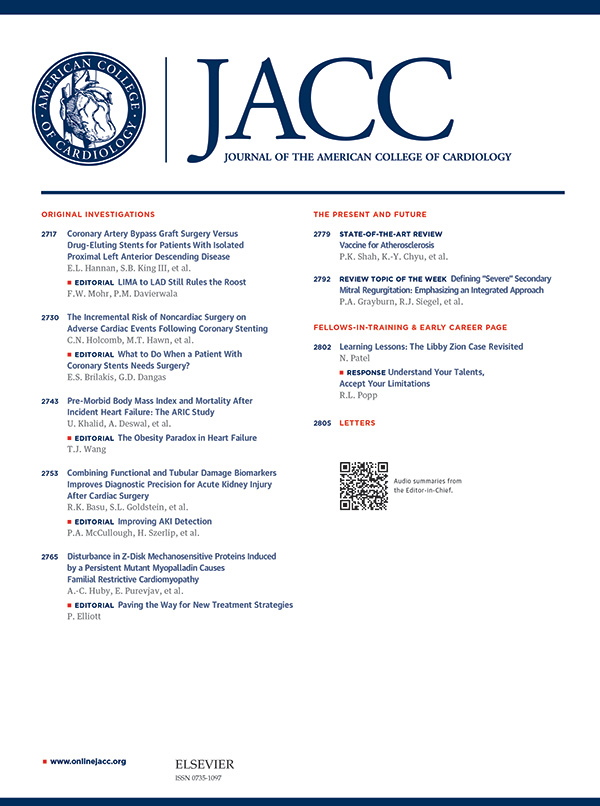Prevalence of Elevated Lipoprotein(a) and its Association With Subclinical Atherosclerosis in 2.9 Million Chinese Adults
IF 21.7
1区 医学
Q1 CARDIAC & CARDIOVASCULAR SYSTEMS
引用次数: 0
Abstract
Background
Elevated lipoprotein(a) [Lp(a)] is strongly associated with an increased risk of atherosclerotic cardiovascular disease; yet, large-scale studies on the epidemiology of elevated Lp(a) as well as its association with subclinical atherosclerosis in the Chinese population are limited.Objectives
This study aimed to estimate the prevalence of elevated Lp(a) in a large check-up population of China, and investigate its associations with both site-specific and multisite subclinical atherosclerosis.Methods
Adults who underwent Lp(a) testing between 2017 and 2023 at Meinian health check-up centers in 30 provinces of China were included. Because the test results of Lp(a) were reported in either the mass unit (mg/dL) or the molar unit (nmol/L) and conversion between units was not recommended, separate analyses were conducted for each unit. Subclinical atherosclerosis was assessed using various imaging examinations at the carotid artery, the brain, and the coronary artery. The prevalence of elevated Lp(a) was estimated across the overall study population and various subpopulations. The logistic regression model was used to investigate the associations between elevated Lp(a) and subclinical atherosclerosis.Results
A total of 2,788,206 and 167,114 participants with the mass unit and the molar unit were included. In the mass unit group, the prevalence of Lp(a) >30 and >50 mg/dL was 18.67% and 8.41%, respectively. Significantly higher prevalence was observed among women, elderly individuals, and individuals with various cardio-renal-metabolic risk factors (all P < 0.05). Compared with Lp(a) ≤30 mg/dL, individuals with Lp(a) >30 to ∼50 mg/dL exhibited 11%, 15%, 9%, and 11% greater odds of increased carotid intima-media thickness, carotid plaque, subclinical brain infarcts, and coronary artery calcification, respectively. The odds were even higher for those with Lp(a) >50 mg/dL. Furthermore, elevated Lp(a) was significantly associated with the extent of coronary artery calcification, as well as subclinical atherosclerosis at 1, 2, and 3 sites, with the association being more pronounced in cases with severe extent and multisite involvement. These results were similar in the molar unit group.Conclusions
A significant burden of elevated Lp(a) was found in China, highlighting the necessity of prioritized Lp(a) screening in high-risk groups. Elevated Lp(a) was identified as a significant risk factor for site-specific subclinical atherosclerosis, with stronger associations observed in severe extent and multisite involvement. Our findings suggest that individuals with elevated Lp(a) should undergo a comprehensive assessment of subclinical atherosclerosis at multiple sites to help prevent ASCVD.

290 万中国成年人中脂蛋白(a)升高的患病率及其与亚临床动脉粥样硬化的关系
背景:脂蛋白(a)升高[Lp(a)]与动脉粥样硬化性心血管疾病风险增加密切相关;然而,关于中国人群中Lp(a)升高的流行病学及其与亚临床动脉粥样硬化的关系的大规模研究是有限的。目的:本研究旨在估计中国大量体检人群中Lp(a)升高的患病率,并探讨其与部位特异性和多部位亚临床动脉粥样硬化的关系。方法选取2017 - 2023年在中国30个省美年健康体检中心接受Lp(a)检测的成年人。由于Lp(a)的检测结果以质量单位(mg/dL)或摩尔单位(nmol/L)报告,且不建议在单位之间进行转换,因此对每个单位分别进行分析。亚临床动脉粥样硬化通过在颈动脉、脑和冠状动脉的各种影像学检查进行评估。估计了整个研究人群和各个亚人群中Lp(a)升高的患病率。采用logistic回归模型探讨Lp(a)升高与亚临床动脉粥样硬化之间的关系。结果共纳入质量单位2788206人,摩尔单位167114人。在质量单位组,Lp(a) >;30和>;50 mg/dL的患病率分别为18.67%和8.41%。在女性、老年人和具有各种心肾代谢危险因素的人群中,患病率明显更高(P <;0.05)。与Lp(a)≤30 mg/dL相比,Lp(a)≤30 ~ 50 mg/dL的个体颈动脉内膜-中膜厚度增加、颈动脉斑块、亚临床脑梗死和冠状动脉钙化的几率分别高出11%、15%、9%和11%。Lp(a) >;50毫克/分升的人患病几率更高。此外,升高的Lp(a)与冠状动脉钙化程度以及1、2、3部位的亚临床动脉粥样硬化显著相关,在严重程度和多部位受累的情况下,这种关联更为明显。这些结果在臼齿单位组相似。结论中国存在显著的Lp(a)升高负担,强调在高危人群中优先筛查Lp(a)的必要性。升高的Lp(a)被确定为部位特异性亚临床动脉粥样硬化的重要危险因素,在严重程度和多部位累及时观察到更强的相关性。我们的研究结果表明,Lp(a)升高的个体应该在多个部位进行亚临床动脉粥样硬化的综合评估,以帮助预防ASCVD。
本文章由计算机程序翻译,如有差异,请以英文原文为准。
求助全文
约1分钟内获得全文
求助全文
来源期刊
CiteScore
42.70
自引率
3.30%
发文量
5097
审稿时长
2-4 weeks
期刊介绍:
The Journal of the American College of Cardiology (JACC) publishes peer-reviewed articles highlighting all aspects of cardiovascular disease, including original clinical studies, experimental investigations with clear clinical relevance, state-of-the-art papers and viewpoints.
Content Profile:
-Original Investigations
-JACC State-of-the-Art Reviews
-JACC Review Topics of the Week
-Guidelines & Clinical Documents
-JACC Guideline Comparisons
-JACC Scientific Expert Panels
-Cardiovascular Medicine & Society
-Editorial Comments (accompanying every Original Investigation)
-Research Letters
-Fellows-in-Training/Early Career Professional Pages
-Editor’s Pages from the Editor-in-Chief or other invited thought leaders

 求助内容:
求助内容: 应助结果提醒方式:
应助结果提醒方式:


